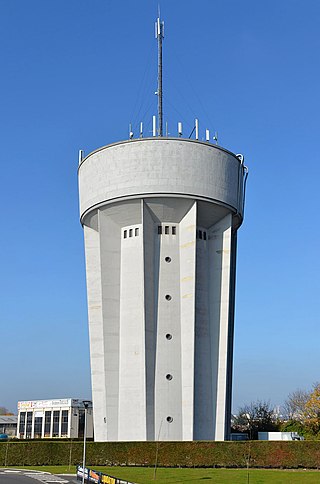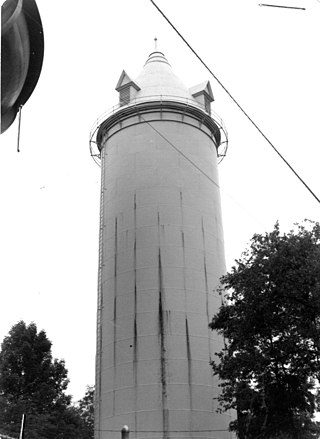
A standpipe is a freestanding pipe fitted with a tap which is installed outdoors to dispense water in areas which do not have a running water supply to the buildings.

A standpipe is a freestanding pipe fitted with a tap which is installed outdoors to dispense water in areas which do not have a running water supply to the buildings.
In the United Kingdom, an "Emergency Drought Order" permits a water company to shut off the primary water supply to homes, and to supply water instead from tanks or standpipes in the streets. This was done in some areas during the 1976 heat wave, for example.
In some Middle Eastern, Caribbean and North African countries a standpipe is used as a communal water supply for neighbourhoods which lack individual housing water service. In areas such as Morocco, standpipes often yield unreliable service and lead to water scarcity for large numbers of people. [1]

A water tower is an elevated structure supporting a water tank constructed at a height sufficient to pressurize a distribution system for potable water, and to provide emergency storage for fire protection. Water towers often operate in conjunction with underground or surface service reservoirs, which store treated water close to where it will be used. Other types of water towers may only store raw (non-potable) water for fire protection or industrial purposes, and may not necessarily be connected to a public water supply.

A fire hydrant, fireplug, or firecock (archaic) is a connection point by which firefighters can tap into a water supply. It is a component of active fire protection. Underground fire hydrants have been used in Europe and Asia since at least the 18th century. Above-ground pillar-type hydrants are a 19th-century invention.

A standpipe or riser is a type of rigid water piping which is built into multi-story buildings in a vertical position, or into bridges in a horizontal position, to which fire hoses can be connected, allowing manual application of water to the fire. Within the context of a building or bridge, a standpipe serves the same purpose as a fire hydrant.
Active fire protection (AFP) is an integral part of fire protection. AFP is characterized by items and/or systems, which require a certain amount of motion and response in order to work, contrary to passive fire protection.
Barbados Water Authority Limited (BWA), a government statutory corporation, is the sole provider of water services. Water supplied by the BWA in Barbados is pumped from wells within natural coral aquifers. The geology of Barbados is mostly composed of karst limestone which acts as a filter medium within the aquifers. The water service in Barbados is reliable and the water supply is safe and refreshing to drink; although the water source naturally of high quality, the BWA treats the potable water supply with chlorine to comply with World Health Organization (WHO) standards.
Standpipe may refer to:

The Eden Park Station No. 7 is a historic structure located in Eden Park in Cincinnati, Ohio, United States. Constructed in the late nineteenth century as a significant part of the city water supply system, it was used for its original purpose for only a few decades. As a work of Cincinnati's most important architect, it has been named a historic site.

College Hill is a neighborhood of the City of St. Louis, Missouri. The name College Hill was given to this area because it was the location of the Saint Louis University College Farm. This area, bounded generally by Warne Ave., O'Fallon Park, I-70, Grand Boulevard, and W. Florissant Ave., was acquired by the University for garden and recreation purposes in 1836. It was subdivided in the early 1870s.

Bellevue Standpipe is a historic water storage tank on Bellevue Hill at Washington Street and West Roxbury Parkway in the Stony Brook Reservation of Boston, Massachusetts. Built in 1914, it is one of three early 20th-century water tanks built as part of Greater Boston's public water supply. The structure was added to the National Register of Historic Places in 1990.

Roxbury High Fort is a historic fort site on Beech Glen Street at Fort Avenue in the Roxbury neighborhood of Boston, Massachusetts. The site now contains a small park and the Cochituate Standpipe, also known as Fort Hill Tower, built in 1869. The fort site was added to the National Register of Historic Places in 1973. The site inspired the name of the Fort Hill neighborhood, which surrounds the area of the High Fort.

The High Service Water Tower and Reservoir, colloquially known as the Tower Hill Tower, is a public water supply facility off Massachusetts Route 110 in Lawrence, Massachusetts. The reservoir was constructed in 1874–75 to provide the city's public water supply, with a gatehouse designed by Charles T. Emerson, a Lawrence architect. The tower was built in 1896 as a high pressure standpipe or water tower. The tower stands 157 feet (48 m) high, and is built out of red brick with granite trim. It is Romanesque in its style, and was designed by George G. Adams, a noted local architect who had been taught by Emerson. The standpipe inside the tower is of steel construction and is 102 feet (31 m) in height. The area above the standpipe includes a balcony capped by a chateauesque roof, with round-arch windows providing views of the area. The main tower is octagonal in shape, with a narrow round staircase tower projection from one side.

The Reading Standpipe was a historic water tower atop a hill near the corner of Auburn and Beacon Streets in Reading, Massachusetts. The 138-foot (42 m) tower was built in 1890-91 as part of Reading's first water supply system and was for many years a significant community landmark. The tower was built of steel and wrought iron in a style reminiscent of medieval fortifications.

Water supply and sanitation in Senegal is characterized by a relatively high level of access compared to most of Sub-Saharan Africa. One of its interesting features is a public-private partnership (PPP) that has operatedin Senegal since 1996, with Senegalaise des Eaux (SDE), a subsidiary of Saur International, as the private partner. It does not own the water system but manages it on a 10-year lease contract with the Senegalese government. Between 1996 and 2014, water sales doubled to 131 million cubic meters per year and the number of household connections increased by 165% to more than 638,000. According to the World Bank, "the Senegal case is regarded as a model of public-private partnership in sub-Saharan Africa". Another interesting feature is the existence of a national sanitation company in charge of sewerage, wastewater treatment and stormwater drainage, which has been modeled on the example of the national sanitation company of Tunisia and is unique in Sub-Saharan Africa.

The Arlington Reservoir is a large water storage tank located on Park Circle in Arlington, Massachusetts. It was constructed by the Metropolitan Water Works between 1921 and 1924 in the Classical Revival style, to provide water storage for Northern Extra-High Service area, consisting of Lexington and the higher elevations of Belmont and Arlington.
Urban water supply in Guinea was privatized from 1989 until 2003 during the presidency of Lansana Conte. His government initiated water privatization for two reasons: First, the World Bank had made private sector participation in urban water supply a condition for a new credit, after the public water utility had been unable to improve service quality under a previous World Bank credit. Second, the government wanted to reduce the budgetary burden from the national public water utility, which was overstaffed and had been unable to collect bills.

Water supply in Southern Sudan is faced with numerous challenges. Although the White Nile runs through the country, water is scarce during the dry season in areas that are not located on the river.

Bissell Street Water Tower is a historic standpipe water tower located at the junction of Bissell Street and Blair Avenue in St. Louis, Missouri. The tower was completed in 1886 and was in service until 1912. It is one of three remaining historic standpipes in Saint Louis, along with the Grand Avenue Water Tower and the Compton Hill Water Tower.

Water Utilities Corporation (WUC) is a government-owned corporation that provides water and waste water management services in Botswana. The Board is appointed by the Minister of Minerals, Energy and Water Resources. The water supply is critically important in the arid or semi-arid environment of Botswana.

The Evansville Standpipe is a historic water tower located in Evansville, Wisconsin. The 80-ft tall steel tower was built in 1901 by the Chicago Bridge & Iron Company, as part of the development of the local water supply system, spurred on by a devastating fire in 1896 that destroyed a large section of downtown Evansville. It was added to the National Register of Historic Places in 2008.

A water distribution system is a part of water supply network with components that carry potable water from a centralized treatment plant or wells to consumers to satisfy residential, commercial, industrial and fire fighting requirements.